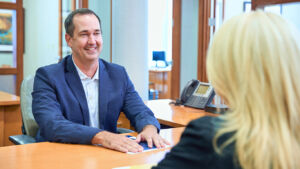When most people think about traditional banking, they envision long lines leading up to the bank teller from their local brick-and-mortar bank.
Well, that style of banking maybe coming to a close. Modern banking can take place at home or on the go. Banking has become as simple as a tap or click of a button. Customers are now able to make deposits, create a loan and manage their accounts online.
Mike Brown, Arizona regional president of Washington Federal Bank, was astounded when he first learned mobile banking was possible.
“I saw an ad on the television and went ‘Wow, that’s pretty amazing,’” Brown recalls. “Now, everybody does it.”
Modern banks are looking at various avenues of banking to maximize profits. The old strategy banks utilized was putting branches in intersections that have a lot of traffic. In today’s banking world, the banking strategies have become more scientific. Many factors, such as demographics and speciialization, are taken into account. No other style of banking has become more important than mobile and online banking. Banks are beginning to invest more on information technology than ever before just to keep up with the dramatic changes in the technolgy and banking world.
“What the next step is?” Brown asks. “Who knows? You’ve got to continually put money into IT just to be prepared for it.”
More banks are closing or amending their brick-and-mortar branches as online and mobile banking grows.
“Probably, the one I thing think about that has changed a lot is on the mobile deposit side, which saw a 49 percent increase (fromm March 2015 to March 2016),” says said Bankers Trust Arizona Market President Patricia F. Rouke. “That’s what is driving your branch traffic and that might be why, at least in our market, you’ve seen some banks close branches because they don’t have that walk-in traffic.”
As banking has evolved, so have the criminals. The days of Bonnie and Clyde may be long gone, but a new criminal has come to take their place — the cyber criminals. Banks are investing money to not only develop new features for online and mobile banking, but to protect their customers from cyber criminals as well. Bankers Trust offers internal cybersecurity to their employees and now spends more on cybersecurity and compliance than they did five to 10 years ago.
“I don’t know the dollar amount, but I will say probably between cybersecurity and new mortgage rules and regulations, I remember our CEO saying, ‘We probably spent a million to a million and a half additional dollars.’ I believe our CEO would still say, along with even our security officer, ‘cybersecurity continues to be probably the No. 1 thing we think about,’” says Rouke.
The convenience of online and mobile banking does not mean the end of in-person banking. In fact, based on customer feedback, Wells Fargo has found that many of their customers still enjoy in-person banking. Banks are opening up more and more micro-branches, which are relatively inexpensive and convenient compared to the brick-and-mortar branches. Washington Federal opened a micro-branch in Ashland, Oregon, inside a retail market to see if they were able attract some new foot traffic.
“The customers are looking for different kinds of opportunities,” says Brown. “There is a lot more foot traffic and a lot more transaction traffic in the micro-branches. Once again, you have to adapt to what that demographic is looking for.”
As part of its growth and development plan, Arizona State Credit Union has changed its name to OneAZ Credit Union. The name change coincides with OneAZ’s ambitious plan to upgrade its infrastructure with a best-in-class phone system with password authentication, voice recognition and other features, along with a next-level digital experience. Prototype branches also are being planned in Sedona and at Kierland Commons in Scottsdale. The branches, set to open this summer and fall, respectively, will feature an Apple-esque design, with consultation, learning and the latest customer service technologies.
“We want to make our contact with members as easy, enjoyable and effective as possible, regardless of how they reach us,” says David Sweiderk, the credit union’s executive vice president and chief operating officer.
Wells Fargo, one of the leaders in mobile banking with 17 million mobile banking customers, has developed an Omni channel strategy which allows their customers to switch from self-service banking, mobile, to full-service banking.
“You click ‘Click-for-care’ and you can turn your mobile phone into a voice-activated system,” says Wells Fargo Regional President Pam Conboy. “Say, ‘I want help’ when you are on your mobile device and you’ll be connected to a Wells Fargo phone representative. You’ll have the opportunity to either go to a VRU (voice response unit) or directly to a banker.”
Mobile and online banking have certainly revolutionized the way many people bank today but it is unclear if these are the final technological products. Banks have invested a lot of money to keep up with the technological advancements. Who knows, we may even see virtual reality banking in the future. Stay tuned.



